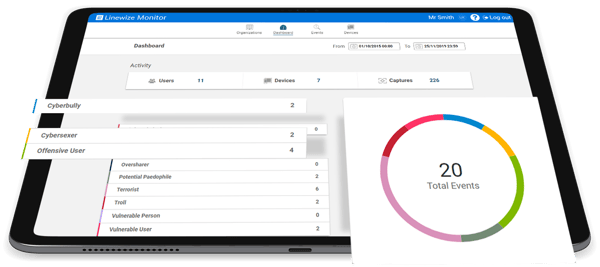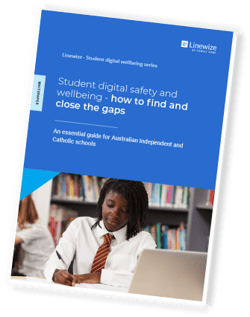Self-harm in Australian Independent Schools – Spotting signs of risk
August 10, 2022
Self-harm has become a significant problem, with rates among children showing a worrying trend. The Growing up in Australia study, conducted in partnership with three Australian Government departments, has found that around one in three adolescents has considered self-injury. The study also discovered that repeated self-injury over time was strongly associated with suicidal behaviour, with 65% of those who engaged in repeated self-injury reported attempting suicide at age 16-17.
These statistics emphasise the importance for school leaders and pastoral staff to know how to spot the signs of self-harm so that the issue can be addressed appropriately and at the earliest stage possible.
Learn how Independent and Catholic schools can address student digital wellbeing challenges and build a positive digital culture.
Download our essential guide, "Student digital safety and wellbeing - how to find and close the gaps."
Causes of student self-harm
There are many influencing factors for young people to self-harm. Pressures of academic achievement, bullying, stress, social media and the glamorisation of suicide have all been cited as common factors.
Students are likely to feel pressure to achieve in independent schools. They are placed in an environment of high-quality facilities, and expert teachers and expectations tend to be high. Fee increases at independent schools are running at nearly twice the rate of inflation and have outpaced wage growth yearly for a decade. Many parents have had to make sacrifices to fund their child's education. This can lead to high expectations of academic achievement and long-term success placed on students. With a strong emphasis on exam grades through league tables, schools also feel the pressure to ensure their students reach the maximum grades possible. The reality is students can only reach the best of their ability, and for some, this may lead to feelings of inadequacy.
A UK study found that almost 1 in 3 suicides in UK children under the age of 20 occurs around exam time. This same study found that over 1 in 4 students had indicated thoughts of suicide leading up to their death.
Looking for signs of student self-harm
It's important for independent schools to be aware of any indications that a student may be at risk of self-harm. However, spotting the signs in a busy classroom can be challenging. Some key signs to look out for include:
- Unexplained injuries
- Wearing excessive clothing even in the summer months
- Changes in behaviour
- Changes to weight
- Eating small or excessive amounts at meal times

How digital safeguarding technology can identify signs of student self-harm
Another way independent schools can identify signs a child may be at risk of self-harm is by analysing their digital behaviour. Students may start to show signs that they might be developing a problem through digital activity, including:
- Internet searches about self-harm and suicide
- Discussions on online chat
- Placing anonymous comments on websites
- Looking at social media sites that glamorise self-harm and suicide
- Expressing self-hate language in text documents
An effective digital safeguarding technology set-up will send alerts to the school's Pastoral Care Team if a student has shown any alarming signs of risk. Sometimes these alerts may appear from concerned peers writing to each other or looking at ways to help a friend. When staff are alerted, they can intervene and implement support measures. Sometimes, alerts may be time-critical. An intelligent digital monitoring solution will work in real-time to inform the appropriate staff immediately, allowing them to act fast.
With school staff time-pressed, some may have concerns that if a student shows signs of being at immediate risk, they will not necessarily see the information in time. Digital safeguarding technology solutions, with a managed service, provide schools with peace of mind that they have added support. Safety experts are constantly monitoring their system so that no risk concerns are missed, and they are informed in real-time when needed. Having a managed service option also saves staff valuable time trawling through reports, as human and AI moderation removes instances of false positives.
To learn more about cutting-edge approaches to student digital wellbeing, see our recent whitepaper, "Student digital safety and wellbeing - how to find and close the gaps. An essential guide for Australian Independent and Catholic schools."

Related Download
Student digital safety and wellbeing - how to find and close the gaps. An essential guide for Australian Independent and Catholic schools.
Our free practical whitepaper is designed to guide you through the challenges around student digital safety and wellbeing and build a positive digital culture.
DOWNLOAD NOW
Related Articles
Digital Safeguarding and Stress – How to spot silent sufferers before it impacts learning outcomes
Picking up subtle behaviour signals that indicate a child is at risk allows staff to intervene and provide the support needed.
READ MORE
Digital Safeguarding Technology in Independent Schools: An unlikely but crucial component in maintaining academic excellence
Discover how this new technology in Australian education can transform your school's academic performance and student outcomes.
READ MORE
Eating Disorders in Independent Schools: Spotting the digital cues
Eating disorders can significantly impact a student's wellbeing and academic achievement. Digital safeguarding technology can identify student concerns as they emerge.
READ MORE
Would you like some more information? Or a demo?
Get in touchSubscribe to our newsletter
Popular posts
Recent posts
Proposed Social Media Ban For Under 16's
Proposed Social Media Ban for Under-16-Year-Olds in Australia: A Step in the Right Direction – But Are We Missing the Mark?
What Student Digital Risks Can Your School Expect in 2024?
Helping Australian Schools Better Safeguard Students This Academic Year
Navigating harmful content online: A guide to managing children’s exposure to distressing content online
In light of current international events, young people may come into contact with distressing online content. This article has been written ...